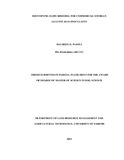| dc.description.abstract | Existence of highly effective rhizobia in African soils is under exploited since
commercial inoculants still contain exotic cultures from United States of America.
Bio-prospecting was conducted in Kenya to identify elite strains of rhizobia
capable of effectively nodulating and fixing large amounts of nitrogen with
commonly grown soybean varieties. One hundred isolates were recovered from
nodules of wild and cultivated legume hosts growing in different agro-ecological
zones, namely coastal sand dunes and mangrove swamps, the uplands and Rift
Valley highlands, to the Afro-montane zone of Mount Elgon and the Lake
Victoria Basin, covering about 1045 km transect. These isolates were
authenticated and tested for effectiveness on soybean (Glycine max) var. SB 19 in
sterile vermiculite, and the twenty-four most promising isolates screened in potted
soil to assess their competitive abilities using two contrasting varieties of soybean
("promiscuously nodulating" SB 19 and specific Safari). The six best performing
isolates were evaluated under field conditions, comparing them to
Bradyrhizobium japonicum strain USDA110, an industry standard. Test isolates
were classified into five categories, non-infective (20%), ineffective (26%), partly
effective (26%), effective (17%) and highly effective (11%) based on their
performance relative to controls and commercial inoculants. The indigenous
rhizobia that outperformed USDA110 were considered highly effective. In potted
soil, all 24 native rhizobia isolates nodulated promiscuous soybean (SB19) but
only 46% of them nodulated specific soybean (Safari). In the field experiment; at
xiii
Nyabeda in west Kenya, NAK 128 performed best on both promiscuous and
specific soybean varieties, significantly (P<0.05) outperforming USDA110 by
29% and 24%, respectively. At another site in Butula, NAK 84 emerged as the
most promising isolate on both promiscuous and specific soybean varieties and
outperforming USDA 110 by 9% and 6%, respectively. The two best isolates
from this investigation, NAK 84 and 128 outperformed the treatment receiving
78 kg N ha-1, require further characterization and field testing but clearly have
commercial potential. | en_US |

